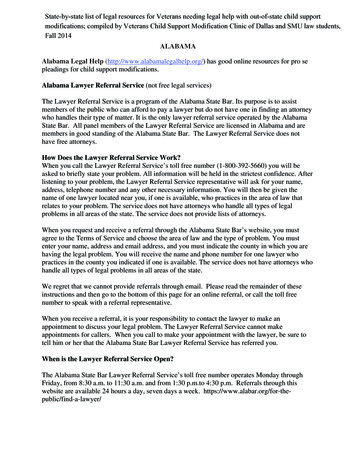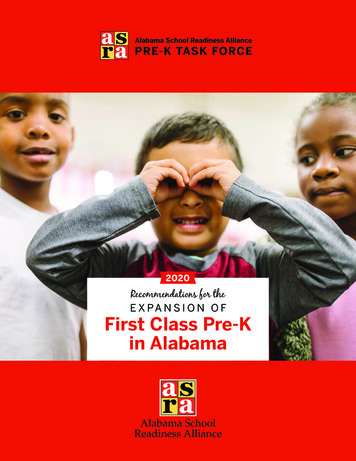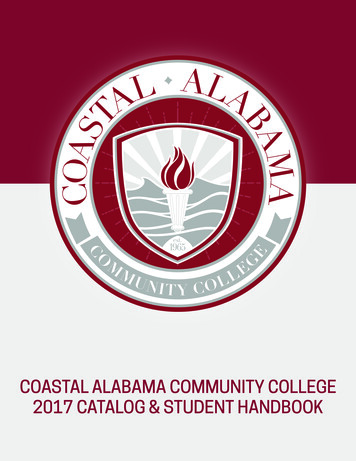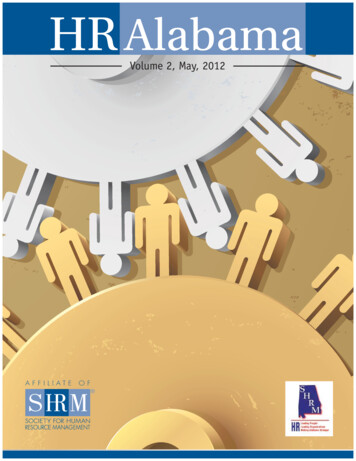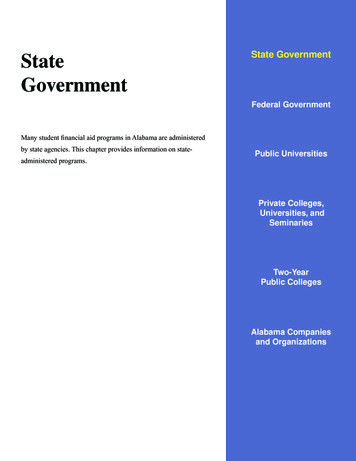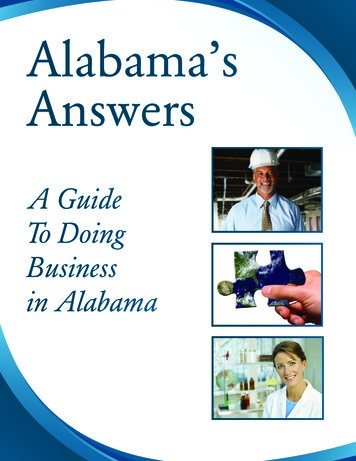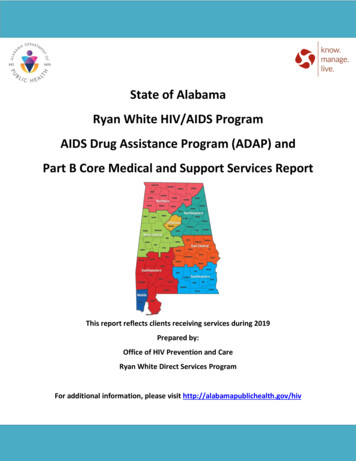
Transcription
State of AlabamaRyan White HIV/AIDS ProgramAIDS Drug Assistance Program (ADAP) andPart B Core Medical and Support Services ReportThis report reflects clients receiving services during 2019Prepared by:Office of HIV Prevention and CareRyan White Direct Services ProgramFor additional information, please visit http://alabamapublichealth.gov/hiv
Alabama Ryan White HIV/AIDS Program ADAP and Part B Services Report, 2019The Health Resources and Services Administration (HRSA), Ryan White HIV/AIDS Program(RWHAP) supports a comprehensive system of care that ensures ongoing access to high qualityHIV care, treatment, and support services. The RWHAP provides services to low-income peoplewith HIV (PWH), as well as their families, who have no health care coverage (public or private),have insufficient health care coverage, or lack financial resources to get the HIV care andtreatment they need to achieve positive health outcomes.Alabama’s RWHAP Part B provides continuous access to life-saving treatment and care for lowincome, uninsured, and underinsured PWH in Alabama through the AIDS Drug AssistanceProgram (ADAP) and Part B core medical and support services. Together, ADAP and Part Bservices provide seamless care and support across the HIV Care Continuum and play an integralrole in the achievement of the National HIV/AIDS Strategy (NHAS) 2020 goals, which include: 1)reducing new HIV infections; 2) increasing access to care and improving health outcomes forPWH; 3) reducing HIV-related disparities and health inequities; and 4) achieving a morecoordinated national response to the HIV epidemic.PWH who achieve and maintain viral suppression are 96 percent less likely to pass HIV on to theirsexual partners. For PWH who reach undetectable levels, there are no documented cases ofsexual transmission. This is the premise of the Prevention Access Campaign’s UndetectableEquals Untransmittable (U U) initiative, which the Centers for Disease Control and Preventionsupports agreeing there is “effectively no risk” of sexually transmitting HIV when on treatmentand undetectable.RWHAP Part B clients receiving ADAP and Part B core medical and support services experienceimproved health outcomes compared to all other PWH in Alabama. Both ADAP and Part Bservices have a measurable impact on the HIV Care Continuum, improving retention in care andviral suppression in Alabama. Specifically, RWHAP Part B clients receiving ADAP and Part B coremedical and support services are close to achieving the NHAS 2020 goal of 90 percent retentionin care and many have already met or surpassed the NHAS 2020 goal of 80 percent viralsuppression (Figure 1).During 2019, 74 percent of PWH receiving ADAP services were retained in care and 83 percentwere virally suppressed (Figure 1). Retention in care and viral suppression are also shownaccording to whether an ADAP client received medication services only, insurance services only,or a combination of both medication and insurance services during 2019. Figure 1 also depictsretention in care and viral suppression among clients receiving Part B core medical and supportservices. During 2019, 79 percent of clients receiving Part B services were retained in care and84 percent achieved viral suppression. In comparison, only 58 percent of all PWH in Alabamawere retained in care and only 66 percent were virally suppressed during 2019. Of note,Alabama’s HIV Care Continuum includes RWHAP clients receiving ADAP and/or Part B coremedical and support services. If Ryan White Part B and ADAP clients were removed fromAlabama’s HIV Care Continuum, retention in care (58 percent) and viral suppression (66 percent)would be even lower.RWHAP Part B and ADAP Grant (HRSA-17-036 CFDA No. 93.917)2
Alabama Ryan White HIV/AIDS Program ADAP and Part B Services Report, 2019Figure 1. Retention in Care and Viral Suppression Among Clients Receiving Ryan White HIV/AIDS Program AIDSDrug Assistance Program (ADAP) and Part B Core Medical and Support Services Compared to all People WithHIV, Alabama 201958%All People With HIV (PWH)in Alabama, 2019 (n 13,774)66%All AIDS Drug Assistance Program(ADAP) Clients (n 3,988)74%ADAP Clients who Received InsuranceServices Only (n 2,710)74%ADAP Clients who Received MedicationServices Only (n 824)75%83%83%84%ADAP Clients who Received BothMedication and Insurance Services(n 454)72%83%79%Part B Core Medical and SupportServices Clients (n 5,762)84%0%20%Retention in Care†40%60%80%100%Viral Load Suppression‡Sources: Alabama Department of Public Health, Office of HIV Prevention and Care, Ryan White Direct Services ProgramNote: Calculations include people with HIV (PWH) receiving Ryan White Part B and/or AIDS Drug Assistance Program (ADAP) services during2019. Retention in care and viral suppression may be slightly underestimated, as a full 12 months to account for delayed reporting oflaboratory results has not yet passed prior to assessing retention in care and viral suppression. In addition, some clients are newly diagnosedand/or returning to care, and have not yet had adequate time to achieve retention in care and viral suppression.Alabama’s preliminary 2019 HIV Care Continuum is not yet published.‡ Calculated as the percentage of clients receiving services during 2019 retained in care, evidenced by 2 CD4, HIV genotype, and/or viral loadtests collected at least 90 days apart in 2019.† Calculated as the percentage of clients receiving services during 2019 whose most recent viral load collected during 2019 was suppressed( 200 copies/mL).Alabama’s RWHAP Part B and ADAP eligibility includes five basic components:1.2.3.4.5.HIV-positive*Alabama residencyFinancial eligibility, currently set at 400 percent of the federal poverty level (FPL)RWHAP Part B must be the payer of last resortBiannual (twice yearly) recertification (birth month and half birth month schedule)Alabama’s ADAP ServicesAlabama’s ADAP offers access to medication and insurance services. Upon enrollment, clientsare enrolled in the most cost-effective plan option available. The majority of PWH applying toADAP outside Marketplace insurance open enrollment periods receive medication services andaccess to Alabama’s ADAP Drug Formulary for uninsured and underinsured clients. To ensureRWHAP Part B and ADAP Grant (HRSA-17-036 CFDA No. 93.917)3
Alabama Ryan White HIV/AIDS Program ADAP and Part B Services Report, 2019the most comprehensive and cost-effective options are available, the majority of ADAP clientsare transitioned to cost-effective ADAP-funded health insurance plans during open enrollment.ADAP clients enrolled in insurance plans have access to any medication covered by the insuranceplan’s drug formulary. Clients enrolled in health insurance are enrolled in the HealthPlusAlabama(HPAL) plan, with optional standalone dental insurance coverage. Currently, all HPAL clients areenrolled in the Blue Cross Blue Shield of Alabama Blue Value Gold plan, with or without coveragein the Blue Dental Select plan. ADAP also provides insurance assistance for PWH enrolled inMedicare Part D prescription drug coverage. Currently, ADAP clients enrolled in the MedicarePart D Client Assistance Program (MEDCAP) are enrolled in the Blue Cross Blue Shield of AlabamaBlue Rx Enhanced Plus Option II plan.During 2019, Alabama’s ADAP provided life-saving medication and/or insurance coverage toalmost 4,000 eligible clients (n 3,988). This is triple the number of clients served prior tolaunching Alabama’s cost-effective ADAP-funded insurance assistance plan in 2015. Alabama’sADAP generates 340B rebates from clients enrolled in cost-effective insurance plans that arereinvested into the program to enhance and expand services. Without the generation of 340Brebates, ADAP and Part B core medical and support services would not be available to as manyclients as Alabama’s RWHAP currently serves.The percentage of ADAP clients receiving different plan options is depicted in Figure 2. Themajority of ADAP clients (68 percent) were exclusively enrolled in ADAP-funded insurance plansduring 2019. In addition to being cost-effective and generating additional 340B rebate resourcesfor the program, clients enrolled in insurance plans have access to comprehensive health carecoverage and an expanded drug formulary managed by the insurance plan. Another 21 percentof ADAP clients received medication services only and 11 percent were enrolled in bothmedication and insurance services at some point during 2019.Figure 2. AIDS Drug Assistance Program (ADAP) Clients Served by Plan Option, Alabama 201911%Insurance Services Only (n 2,710)21%Medication Services Only (n 824)68%Both Medication and Insurance Services (n 454)Source: Alabama Department of Public Health, Office of HIV Prevention and Care, Ryan White Direct Services ProgramIn addition to assessing retention in care and viral suppression by the type of ADAP servicesreceived, it is helpful to review health outcomes by client groups to identify high risk populationsin need of targeted outreach, education, and/or enhanced services. Figure 3 depicts retention incare and viral suppression outcomes among ADAP clients for specific demographic and otherclient characteristics.RWHAP Part B and ADAP Grant (HRSA-17-036 CFDA No. 93.917)4
Alabama Ryan White HIV/AIDS Program ADAP and Part B Services Report, 2019Figure 3. Retention in Care and Viral Suppression Among Clients Receiving Ryan White HIV/AIDS Program AIDSDrug Assistance Program (ADAP) Services by Client Characteristic, AlabamaAll People With HIV (PWH)in Alabama, 2019 (n 13,774)58%66%74%Total ADAP Clients (n 3,988)83%73%Male (n 2,992)83%79%83%Female (n 926)70%Transgender (n 70)83%74%Black or African American (n 2,635)81%76%White (n 894)87%77%Hispanic (n 194)87%75%Multi-racial (n 257)83%63%63%Other Race/Ethnicity (n 8)71%13-24 years (n 226)77%73%25-44 years (n 2,328)81%77%45-64 years (n 1,375)86%78% 65 years (n 59)90%MSM (n 2,154)73%IDU (n 144)73%83%86%70%MSM/IDU (n 137)85%79%82%Heterosexual (n 1,067)64%Perinatal (n 25)52%73%Unknown/Other Risk (n 461)81%0%20%Retention in Care†40%60%80%100%Viral Load Suppression‡Sources: Alabama Department of Public Health, Office of HIV Prevention and Care, Ryan White Direct Services ProgramNote: Calculations include persons with HIV (PWH) receiving AIDS Drug Assistance Program (ADAP) services during 2019. Retention in care andviral suppression may be slightly underestimated as the standard is to allow a full 12 months before analyzing data to account for delayedreporting of laboratory results. Case counts less than 12 may be due to chance and should be interpreted with extreme caution.‡ Calculated as the percentage of clients receiving ADAP services during 2019 who were retained in care, evidenced by 2 CD4, HIV genotype,and/or viral load tests collected at least 90 days apart in 2019.† Calculated as the percentage of clients receiving ADAP services during 2019 whose most recent viral load collected during 2019 wassuppressed ( 200 copies/mL).RWHAP Part B and ADAP Grant (HRSA-17-036 CFDA No. 93.917)5
Alabama Ryan White HIV/AIDS Program ADAP and Part B Services Report, 2019While all ADAP clients experienced 83 percent viral suppression, regardless of gender identity,differences are seen in retention in care. Individuals identifying with their birth sex have betterretention in care compared to those identifying as transgender (either male-to-female or femaleto-male). Among cisgender females, 79 percent were retained in care. Among cisgender males,73 percent were retained in care. However, only 70 percent of transgender clients were retainedin care, signifying a need for enhanced services among this group.Racial and ethnic disparities are also seen in retention in care and viral suppression, withindividuals identifying as white, Hispanic, and multi-racial having better outcomes than thoseidentifying as African American or other/unknown race and ethnicity. Seventy-four percent ofAfrican Americans were retained in care and 81 percent were virally suppressed. Amongindividuals reporting another or unknown race, only 63 percent were retained in care and virallysuppressed. This is a difference of more than 10 percent for retention in care from other racialand ethnic groups and a difference of 20 percent or more in viral suppression. To eliminatedisparities among clients reporting other or unknown race, enhanced services are needed.Stratification by age shows improved retention in care and viral suppression as clients mature,with clients 65 years and older experiencing the best outcomes. This signifies a need for closermonitoring and follow-up among younger clients, especially adolescents and young adults 13 to24 years who also represent the majority of newly diagnosed HIV infections. It is worth notingthat no clients receiving ADAP services were 12 years old or younger. By law, the RWHAP mustbe the payer of last resort. The majority of children in low income families are able to obtainhealthcare coverage through Alabama’s Medicaid and AllKids insurance programs. However, if achild was underinsured or otherwise unable to enroll in Medicaid or AllKids, ADAP medicationonly services would be available as an option.Assessing retention in care and viral suppression by HIV risk factor also shows similar variations,with individuals infected perinatally experiencing the greatest disparity. Only 64 percent of PWHinfected at birth were retained in care and only 52 percent were virally suppressed. This maysignify antiretroviral resistance and/or treatment fatigue among PWH infected perinatally, asthese individuals have been managing their HIV infection since birth or early childhood diagnosis.With the vast array of HIV treatment regimens available, including several single-tablet regimens,care should be taken with this group to assess for antiviral resistance patterns, treatment fatigue,or other issues negatively affecting HIV care outcomes.While disparities among other groups were not as large, improvement should still be made.Among men who have sex with men (MSM), 73 percent were retained in care and 83 percentwere virally suppressed, while 70 percent of MSM with a history of injection drug use (IDU) wereretained in care and 85 were virally suppressed. Outcomes among PWH with IDU alone were 73percent retention in care and 86 percent viral suppression and those of unknown or other riskfactor were 73 percent retention in care and 81 percent viral suppression. Enhanced ADAPservices across all risk factor groups may improve retention in care and viral suppression andpositively affect Alabama’s HIV Care Continuum as a whole, moving towards Ending the HIVEpidemic.RWHAP Part B and ADAP Grant (HRSA-17-036 CFDA No. 93.917)6
Alabama Ryan White HIV/AIDS Program ADAP and Part B Services Report, 2019The majority of clients receiving ADAP services achieve viral suppression, although the levelvaries by ADAP plan option. Clients enrolled in insurance plans achieve better outcomes thanthose accessing medication only services (Figure 4). It should be noted that newly diagnosedand/or returning clients are typically enrolled in medication only services. These clients may nothave been in care long enough to achieve viral suppression.Figure 4. Viral Load Range of ADAP Clients by Plan Option, Alabama 20195%2%2% 6%1%2%2%12%7%3%2%3%2%3%2%84%79%Insurance Services Only (n 2,710)83%Medication Services Only (n 824)Both Medication & Insurance (n 454) 200 copies/mL200-600 copies/mL601-1,000 copies/mL1,001-5,000 copies/mL 5,000 copies/mLno viral load test reportedSource: Alabama Department of Public Health, Office of HIV Prevention and Care, Ryan White Direct Services ProgramADAP - AIDS Drug Assistance Program. Most recent viral load collected during 2019. Percentages may not total 100% due to rounding.In addition to viral load suppression, improved access to care and antiretroviral adherence isassociated with increased CD4 counts and reduced progression to AIDS. Stratification by ADAPplan option reveals the majority of clients experience non-AIDS defining CD4 counts (i.e., CD4 200 cells/µL), regardless of plan type (Figure 5). Annual CD4 testing is no longer required forPWH with consistently healthy CD4 counts. This may account for some missing CD4 tests.Figure 5. CD4 Count Range of ADAP Clients by Plan Option, Alabama 201920%4%8%13%18%22%7%25%28%51%50%54%Insurance Services Only (n 2,710) 200 cells/µLMedication Services Only (n 824)200-499 cells/µL 500 cells/µLBoth Medication & Insurance (n 454)No CD4 count reportedSource: Alabama Department of Public Health, Office of HIV Prevention and Care, Ryan White Direct Services ProgramADAP - AIDS Drug Assistance Program. Most recent CD4 counts collected during 2019. Percentages may not total 100% due to rounding.RWHAP Part B and ADAP Grant (HRSA-17-036 CFDA No. 93.917)7
Alabama Ryan White HIV/AIDS Program ADAP and Part B Services Report, 2019More Hispanics are uninsured (13 percent) and receive medication services only compared to thepercentage receiving insurance services (Figure 6). This may be due to Alabama’s undocumentedHispanic population as Blue Cross Blue Shield of Alabama does not allow enrollment in insuranceplans without a valid social security number. Another notable aspect is the large percentage ofAfrican Americans. African Americans are disproportionately affected by HIV. While AfricanAmericans comprise only 27 percent of Alabama’s total population, they represent over 60percent of prevalent cases and over 65 percent of newly diagnosed HIV infections in Alabama.Figure 6. Race/Ethnicity of ADAP Clients by Plan Option, Alabama 20190%7%3%0%6%2%1%4%13%65%66%24%69%23%18%Insurance Services Only (n 2,710)Black or African AmericanMedication Services Only (n 824)WhiteHispanicBoth Medication & Insurance (n 454)Multi-RacialOther/UnknownSource: Alabama Department of Public Health, Office of HIV Prevention and Care, Ryan White Direct Services ProgramADAP - ADIS Drug Assistance Program. Percentages may not total 100% due to rounding.The majority of ADAP clients identify with their birth sex, with males accounting for the largestpercentage of clients, mirroring the HIV epidemic in Alabama (Figure 7). While a largerpercentage of males are uninsured receiving medication services only, a larger percentage offemales are enrolled in insurance plans. Although no difference is seen among transgenderclients across ADAP plan options, Alabama’s transgender population is growing with 70 ADAPclients identifying as transgender during 2019.Figure 7. Gender Identity of ADAP Clients by Plan Option, Alabama 201925%2%19%2%73%Insurance Services Only (n 2,710)Male21%2%76%79%Medication Services Only (n 824)FemaleBoth Medication & Insurance (n 454)TransgenderSource: Alabama Department of Public Health, OFfice of HIV Prevention and Care, Ryan White Direct Services ProgramADAP - AIDS Drug Assistance Program. Percentages may not total 100% due to rounding.RWHAP Part B and ADAP Grant (HRSA-17-036 CFDA No. 93.917)8
Alabama Ryan White HIV/AIDS Program ADAP and Part B Services Report, 2019The majority of ADAP clients were 25 to 44 years during 2019. However, a smaller percentage ofthis age group was enrolled in insurance coverage compared to medication only services. Thesame trend is seen when assessing adolescents and young adults age 13 to 24 years. Incomparison, a larger percentage of older clients age 45 and older were enrolled in insurance.This could account for the improved retention in care and viral suppression among older, moremature ADAP clients, as health insurance offers more comprehensive coverage than access tomedications services only.Figure 8. Age Range of ADAP Clients by Plan Option, Alabama 20196%9%24%39%29%0.7%1.8%0.8%4%55%64%66%Insurance Services Only (n 2,710) 12 YearsMedication Services Only (n 824)13-24 Years25-44 YearsBoth Medication & Insurance (n 454)45-64 Years 65 YearsSource: Alabama Department of Public Health, Office of HIV Prevention and Care, Ryan White Direct Services ProgramADAP - ADIS Drug Assistance Program. Age as of December 31, 2019. Percentages may not total 100% due to rounding.Alabama’s financial eligibility for both ADAP and Part B services is set at 400 percent of the federalpoverty level (FPL). The majority of ADAP clients are extremely low income, living below 100percent of the FPL (Figure 9). However, there is greater utilization of insurance services amongclients with higher incomes, signifying a need for increased education about the ADAP insuranceplan options for clients with lower incomes.Figure 9. Income Level of ADAP Clients by Plan Option, Alabama 20194%3%6%6%6%64%14%4%5%10%5%71%81%10%10%Insurance Services Only (n 2,710) 100% FPL100-138% FPLMedication Services Only (n 824)139-200% FPL201-250% FPLBoth Medication & Insurance (n 454)251-400% FPL 400% FPLSources: Alabama Department of Public Health, Office of HIV Prevention and Care, Ryan White Direct Services ProgramFederal Register, Vol. 85, No. 12, January 17, 2020, pp. 3060-3061. Also see https://aspe.hhs.gov/poverty-guidelines.ADAP - AIDS Drug Assistance Program. Percentages may not total 100% due to rounding.RWHAP Part B and ADAP Grant (HRSA-17-036 CFDA No. 93.917)9
Alabama Ryan White HIV/AIDS Program ADAP and Part B Services Report, 2019Alabama’s Part B Core Medical and Support ServicesAlabama funds 16 Ryan White Providers across the state to provide Part B core medical andsupport services. Part B services offered in Alabama include:1.2.3.4.5.6.7.8.Outpatient/Ambulatory Medical CareOral Health CareEarly Intervention Services (to help identifyHIV-positive persons and link them to care)Health Insurance Premium & Cost SharingAssistanceMental Health ServicesMedical Nutrition TherapyMedical Case Management (includingTreatment Adherence)Substance Abuse Services (Outpatient)9.10.11.12.13.14.15.16.17.18.Case Management (Non-medical)Emergency Financial AssistanceFood Bank/Home-delivered MealsHealth Education/Risk Reduction ServicesHousing ServicesOther Professional Services (including LegalServices)Linguistic ServicesMedical Transportation ServicesPsychosocial Support ServicesReferral for Health Care/Support ServicesDuring 2019, Part B services were provided to more than 5,700 eligible PWH. Figure 10 stratifiesPart B clients into demographic groups to identify disparities. Significant disparities representopportunities for target interventions and enhanced services among high risk groups.Assessment of gender identity reveals the majority of clients receiving Part B services identifywith their birth sex (cisgender). However, Alabama’s transgender population is growing with 77transgender clients receiving Part B services during 2019. Cisgender clients experienced slightlybetter outcomes compared to transgender clients. Interventions focused on transgender clientscould improve retention in care and viral suppression among this client group.Assessment of race and ethnicity reveals White, Hispanics, and multi-racial clients experiencedbetter retention in care and viral suppression than African Americans and other or unknown race.Less than 80 percent of African Americans were retained in care and only 65 percent of thosewith other or unknown race were retained in care. Similar differences were seen in viralsuppression, with only 83 percent of African Americans virally suppressed. This signifies a needfor ramped up interventions among African Americans and clients of other or unknown race.Stratification by age reveals a trend towards improved HIV care as PWH mature. Excludingchildren less than 13 years, retention in care and viral suppression improved with age during2019. This signifies a need for enhanced HIV prevention and care efforts among adolescents andyoung adults age 13 to 24 years. This age group also represents the majority of newly diagnosedinfections, further signifying a need for enhanced efforts while these individuals learn tosuccessfully manage their HIV diagnosis.Stratifying clients by risk factor also reveals a need for better viral suppression among perinatalinfections. While 82 percent of perinatal infections are retained in care, only 68 percent arevirally suppressed, denoting a disconnect between retention in care and viral suppression. Aswith ADAP clients, this may signify antiretroviral resistance and/or treatment fatigue amongindividuals exposed perinatally.RWHAP Part B and ADAP Grant (HRSA-17-036 CFDA No. 93.917)10
Alabama Ryan White HIV/AIDS Program ADAP and Part B Services Report, 2019Figure 10. Retention in Care and Viral Suppression Among Clients Receiving Ryan White HIV/AIDS Program PartB Core Medical and Support Services by Client Characteristic, Alabama 2019All People With HIV (PWH)in Alabama, 2019 (n 13,774)58%66%79%Total Part B Service Clients (n 5,762)78%Male (n 3,925)84%85%81%83%Female (n 1,760)73%Transgender (n 77)82%78%83%Black or African American (n 3,919)80%White (n 1,304)88%81%Hispanic (n 193)87%81%85%Multi-racial (n 326)65%Other Race/Ethnicity (n 20)85%80% 13 years (n 10)73%13-24 years (n 369)78%76%25-44 years (n 2,526)90%81%81%45-64 years (n 2,514)87%83% 65 years (n 342)78%MSM (n 2,624)85%81%IDU (n 325)77%MSM/IDU (n 216)90%86%85%81%84%Heterosexual (n 1,897)Perinatal Exposure (n 60)82%68%74%Unknown/Other (n 640)0%20%Retention in Care‡40%60%80%81%100%Viral Load Suppression†Sources: Alabama Department of Public Health, Office of HIV Prevention and Care, Ryan White Direct Services Program.Abbreviations: IDU – intravenous drug use; MSM – men who have sex with men.Note: Calculations include persons with HIV (PWH) receiving Ryan White Part B services during 2019. Retention in care and viral suppressionmay be slightly underestimated as the standard is to allow a full 12 months before analyzing data to account for delayed reporting of laboratoryresults. Case counts less than 12 may be due to chance and should be interpreted with extreme caution.‡ Calculated as the percentage of clients receiving Part B services during 2019 who were retained in care, evidenced by 2 CD4, HIV genotype,and/or viral load tests collected at least 90 days apart in 2019.† Calculated as the percentage of clients receiving Part B services during 2019 whose most recent viral load collected during 2019 was suppressed( 200 copies/mL).RWHAP Part B and ADAP Grant (HRSA-17-036 CFDA No. 93.917)11
Alabama Ryan White HIV/AIDS Program ADAP and Part B Services Report, 2019Stratifying clients by Part B core medical and/or support service category received also revealsvariation in retention in care and viral load suppression (Figure 11). Among the 5,762 clientsaccessing Part B services during 2019, clients receiving health insurance premium and costsharing assistance achieved the best retention in care (91 percent) while clients accessinglinguistic services achieved the best viral suppression (95 percent). In fact, clients receivinghealth insurance premium and cost sharing assistance have already surpassed the NHAS 2020indicator goal of 90 percent retention in care. As with ADAP, this is not surprising as having accessto health insurance provides a comprehensive system of care to manage HIV infection andsupport overall health.It should be noted that all Part B service categories (excluding early intervention services) havealready surpassed the NHAS 2020 indicator goal of 80 percent viral suppression.Earlyintervention services include HIV testing in support of early identification of individuals with HIV.Poorer outcomes are expected among clients identified through this service category as theyoften represent newly diagnosed and/or returning to care individuals who tested (or retested)positive for HIV and have not yet had time to achieve retention in care and viral suppression.PWH must be diagnosed and living with HIV for at least 12 months to successfully measureretention in care. Further, many HIV treatment regimens take a minimum of 90 days to becomeeffective at suppressing HIV. For these reasons, retention in care of 22 percent and viralsuppression of 44 percent are not alarming among PWH receiving early intervention HIV testingservices. While early intervention services may not appear to be an effective service categorywhen assessing retention in care and viral suppression, increasing awareness of HIV status iscritical to ending the HIV epidemic. A comprehensive system of care is required to achieve acoordinated response to the HIV epidemic and end new HIV transmissions.Another way to gauge the overall effectiveness of Part B core medical and support categories isto assess utilization. Non-medical case management (n 3,573) received the highest utilizationduring 2019, followed by medical case management, including treatment adherence services(n 3,141), food bank/home delivered meal (n 1,805), medical transportation services (n 1,797),and outpatient/ambulatory health care (n 1,271). Although linguistic services (n 63) receivedthe lowest utilization of all service categories, clients receiving this service category experiencedthe best viral suppression of all service categories (95 percent). This signifies the importance ofoffering linguistic services as an available option for clients accessing Ryan White services.Considering the success of this service category, coupled with Alabama’s significant populationof migrant seasonal workers, linguistic services should be expanded and made available to morenon-English speaking clients.When assessing retention in care and viral suppression among Part B Services clients, it shouldbe noted that Part B core medical and support service categories are not mutually exclusive andcannot be compared as such (i.e., a client may receive multiple core medical and/or supportservices through Alabama’s RWHAP Part B program). For more information about Alabama’sRWHAP Part B Program, including program eligibility requirements and a current list of all ADAPRx formulary medications covered by ADAP, please visit http://alabamapublichealth/hiv.RWHAP Part B and ADAP Grant (H
Ryan White HIV/AIDS Program AIDS Drug Assistance Program (ADAP) and . During 2019, Alabama's ADAP provided life-saving medication and/or insurance coverage to almost 4,000 eligible clients (n 3,988). This is triple the number of clients served prior to launching Alabama's cost-effective ADAP-funded insurance assistance plan in 2015. .
